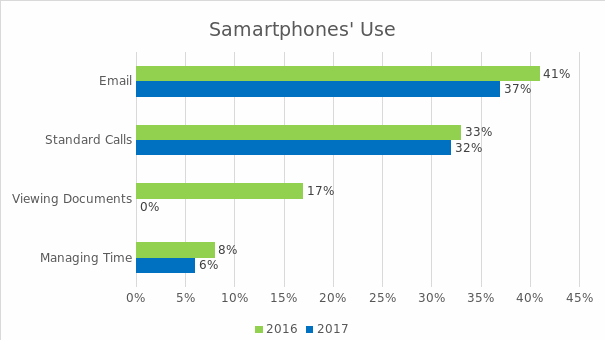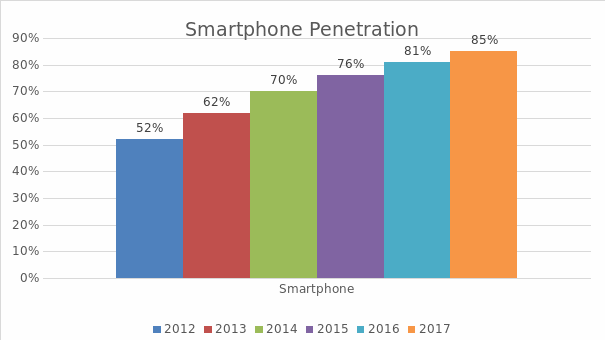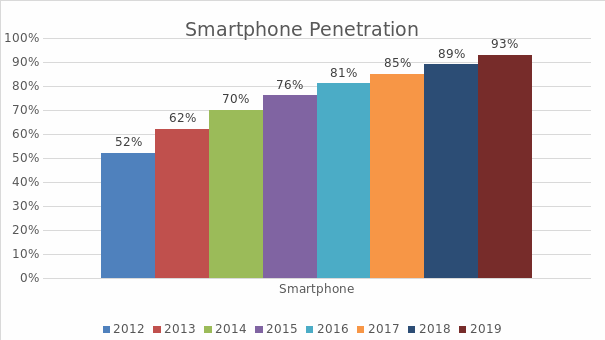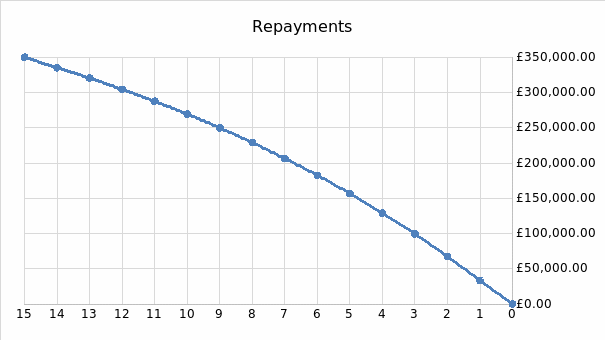Introduction
The given report is devoted to the analysis of the mobile phone market in the UK using the case of Eco-Fone. The increased importance of this technology and its availability to clients result in the growing sales and increase in the number of users every year (Good Morning Britain, 2015). For this reason, the report evaluates peculiarities of Eco-Fone such as customers’ satisfaction, demand, and their satisfaction levels. At the same time, this investigation is supported by the overview of the whole segment to outline perspectives for future evolution and growth, which is vital for the selected company.
Analysis of Issues for Eco-Fone Smartphones
An Overview of the Mobile Phone Market in the UK
The mobile phone market in the UK experiences a significant growth at the moment due to the increased availability and affordability of the technology. There are about 32 million people who are in work and who can be considered the target audience for companies operating in the given sector (Deloitte, 2017). Mobile phones are employed by this cohort as a useful tool that can help to accomplish some tasks or simplify some work-related activities. For this reason, there are multiple opportunities for the generation of stable revenue.
The chart below demonstrates that four main activities that are usually associated with the use of smartphones in the workplace.

In the majority of cases, clients use their phones for reading their emails (41% and 37% in 2016 and 2017 correspondingly) (Deloitte, 2017). The next popular activity presupposes making standard calls associated with the work or clients’ duties (33% and 32%). In 2016, a significant number of individuals used their smartphones for viewing documents; however, in 2017 this tendency decreased as 0% of respondents reported about this way of using their phones (Deloitte, 2017). Finally, these devices remained an effective time management tool as 8% in 2016 and 6% in 2017 of individuals used them with this purpose (Deloitte, 2017).
Companies should also keep in mind the fact that 44% in 2016 and 50% in 2017 customers use smartphones for other work-related activities, which means that there are opportunities for expansion and covering these areas by introducing new models or services to the target audience (Deloitte, 2017).
Forecasting the UK Adult Smartphone Use
The smartphone market in the UK is characterised by the stable growth that is preconditioned by multiple opportunities associated with the utilisation of the given technology. Figure 2 demonstrates a significant increase in the number of adult people who use phones in their daily life.

The given chart proves that more and more individuals accept this technology and start to use to perform various activities. To forecast the future use of smartphones in the UK market, it is recommended to use the exponential model as the linear model will not suffice. It is explained by the absence of the succession and irregular alterations in data related to the topic. In such a way, using the exponential model, the following forecasting about 2018 and 2019 can be acquired:

In such a way, it is expected that in 2018 and 2019, 89% and 93% of individuals will have smartphones, and this fact introduces multiple opportunities for companies.
Smartphones – A potential Market for Older Customers
Another significant factor that should be considered by Eco-Fone is the tendency towards the increase in the number of older customers who start using smartphones. The recent investigation of the market shows that 71% of individuals aged 55 and older own a headset (Kelion, 2017). Additionally, this very group demonstrates a high speed of the technology’s adoption which transforms it into an attractive cohort that might help companies operating in the market of mobile phones to increase their revenue (Anderson and Perrin, 2017). In such a way, representatives of the older generation accept the current trends related to digitalisation and buy smartphones that might increase their comfort levels.
Investigations also admit the fact that people from 55 to 75 usually have high wealth levels, which makes them attractive for producers as they might afford premium headsets or other services offered by companies (Kelion, 2017). However, there is also another way of being involved in using phones presupposing that children give their old models to older parents (Mellor, 2020). Both these ways are effective in popularising these devices and facilitating the further rise of the given industry.
Finally, in some cases, older customers are forced to buy smartphones as they are an integral part of the modern world and some activities can be performed only using this technology (Yu et al., 2018). Nevertheless, market research shows that older customers become active users and contribute to the evolution of the given sphere (Kelion, 2017). From another hand, they attract the attention of companies that might consider them their target audience (ODea, 2020).
Feasibility of Expanding Business to Kingston Using Pros and Cons Table
Figure 4. Pros and cons.
The decision to expand and enter new markets is an important strategical step that can help the company to evolve and improve its position. At the same time, it also has multiple risks that should be considered when moving forward and trying to operate in new environments. For Eco-Fone the application of the pros and cons method helps to conclude about the possible business expansion to Kingston. The list of advantages includes such important aspects as the acquisition of new clients, better opportunities for growth, new departments, enhancement of the brand image, stable and high income acquired because of the demographics of the area, and overall improvement of the company’s work. The total pros count 60, with an average of 8.57.
At the same time, there are multiple risks such as rivalry, unfamiliar environment, the resistance of clients and high cost of additional promotion and expansion, along with the risk of failure. Altogether, the total cons count 49, with an average of 7. It means that the comparison method shows that Eco-Fone should accept the strategic decision to expand to Kingston as it might introduce multiple opportunities for the future growth and empowerment of the company in the given market segment.
Costs of a New Building
Cost of a new building might be a significant factor limiting Eco-Fone opportunities for further growth. Considering that the price for the building constitutes £350,000, and the terms of 15-year repayment mortgage presuppose 7% rate, the company will have to pay £3 145,90 every month to return the full sum by the end of the period. The given cost can be considered appropriate and affordable as far as the firm operates in the highly attractive market and counts for the broadening of its target audience and generation of additional revenue by entering new markets.
At the moment, there are some commercial mortgage loan lenders in the UK, such as THINK Business Loans Commercial Mortgages. The following graph of repayments is offered:

The conditions offered by this lender will presuppose the amount of payment mentioned above, with the total loan amount and total interest payable £566261.81 and £216261.81 correspondingly.
Testing the Possible Difference in Net Takings in the Two Shops
The company that is concerned with the determination of its net taking should also take into account the fact that the standard deviation should be lower because it will contribute to the emergence of profitable and beneficial situations.
Thus, standard deviation represents the current and relevant difference between mean and desired outcome (Bruce and Bruce, 2017). It also means that the increased variance between these two types of deviations might influence the validity of strategies accepted by the frim and their reliability. For this reason, it is critical to implement measures that will help to minimise gaps between actual and standard outcomes (Bruce and Bruce, 2017). Otherwise, the standard deviation outcome will continue to grow, which is not acceptable regarding the profitability and market value of a brand.
Eco-Fone proposes phones and other goods on discounted rates in two compared retail shows with the profitability mean 100 and 90 appropriately. However, the sample size, 40 on net daily takings, remains the same with the standard deviation determined as 20 and 40. For this reason, a comparison of these two units shows that one shop managed to acquire higher profitability levels as against another one. With the increase in the sample size and mean, validity will decrease, but in the first case, with sample size 40 and mean 100, the variation will be better because of the low validity. Two compared shops do not have similar net takings or net profitability. It means that there is a significant difference in net takings of the compared units that come from the presented data.
Customer Satisfaction
Customer satisfaction is a critical factor impacting the functioning of companies as it preconditions the high demand on their products and the image of the brand (Kotler and Keller, 2015). For Eco-Fone, data from the survey indicates the current trends in clients’ attitudes to products.
For question 1, the average meaning is 2.9, or 3. It means that the majority of respondents purchased the product or service between 3 or 6 months. It shows that they are mainly satisfied with items and are ready to buy it.
For question 2, the average meaning is also close to 3. It shows that the average term of the phone’s use is from 1 to 3 years, which indicates comparatively high devotion level and overall satisfaction with services and functions that are provided with the device.
For question 3a, the most common answer is 2. It states for the fair quality of customer service.
For 3b, the average value is 2.5, which also demonstrates the fair quality of products
For 3c, the meaning is 3, or the majority of clients describe sales staff as good.
For 3d, the value is 2.5, which means that the combination price/value is considered by clients as fair.
In general, this domain needs improvement as such characteristics as “fair” is not sufficient enough to guarantee the further evolution of the brand.
Question 4 scores 2.5, which means that the majority of customers are dissatisfied with the company, which is a threatening sign for Eco-Fone.
For question 5, the average meaning is 2.5, meaning that clients will unlikely to continue using the firm’s products.
Finally, from question 6, (averageg3.7) it comes that clients will likely to recommend products of the company to others.
Quality Procedures
Quality improvement another critical process that predetermines the functioning of the company and its outcomes (Besterfield, 2012). For this reason, for Eco-Fone, it is essential to monitor the quality of its services, including invoices. At the moment, it sends about 10,000 invoices every month with an average of two returned. However, in accordance with quality assurance procedures, it is vital to guarantee that the probability of invoices’ return should be less than fifteen percent. Under these conditions, the use of Poisson distribution becomes justified. The given approach is used to predict the number of events over a specific period of time, which can be applied to the case with invoices and their returns.
In such a way, the given function can be applied to the case to calculate potential problems that might emerge in the future and probability of the invoice’s return. Now, with two returned invoices per month, the company might face significant problems in the future. The ability of the company to achieve the desired goal can be calculated using the Poisson formula, where µ=2, as average 2 are returned every month, and x=3 since there is the need to determine the likelihood that only 3 invoices will be returned during the period:
P(x; μ) = (e-μ) (μx) / x! (Bruce and Bruce, 2017)
P(3; 2) = (2.71828-2) (23) / 3!
P(3; 2) = (0.13534) (8) / 6
P(3; 2) = 0.180
(e is a constant 2.71828)
The probability that 3 invoices will be returned is 18%, which is too high.
Conclusions & Important Findings
Altogether, the given report presents the current state of the UK mobile phones market and the peculiarities of Eco-Fone company that operates in the given segment. From the paper, one can see the tendency towards the increase in the number of smartphone users. Forecast made in terms of the work shows that more than 90% will own this device in the future, which offers multiple opportunities for manufacturers and distributors. Additionally, older people start to employ smartphones in their daily activities, which makes them a potentially attractive target audience.
As for the Eco-Fone company, it has some strengths and weaknesses. First, it can expand to other regions such as Kingston to broaden its target audience and affect new areas. Additionally, they can benefit from the growth of the potential market due to the involvement of older adults. At the same time, customer satisfaction levels remain high as the majority of clients evaluate services as fair, and will unlikely to continue using the firm’s products. For this reason, there is a critical need for sufficient quality improvement and change management that will provide new clients with new services and products that will be able to meet their requirements.
References
Anderson, M. and Perrin, A. (2017) ‘Technology use among seniors’, Pew Research Center.
Besterfield, D. (2012) Quality improvement. 9th edn. London: Pearson.
Bruce, P. and Bruce, A. (2017) Practical statistics for data scientists: 50 essential concepts. New York, NY: O’Reilly Media.
Deloitte (2017) State of the smart: consumer and business usage patterns. Global mobile consumer survey 2017: UK cut.
Good Morning Britain (2015) Phone addiction | good morning Britain.
Kelion, L. (2017) ‘Smartphone sales boom with over-55s’, BBC News. Web.
Kotler, P. and Keller, K. (2015) Marketing management.15th edn. New York, NY: Pearson.
Mellor, M. (2020) ‘Sorry, 5G is not going to save falling smartphone sales in the UK’, Wired.
ODea, S. (2020) Market share of leading mobile device vendors in the United Kingdom (UK) from 2010 to 2019.
Yu, X. et al. (2018) ‘The impact of smartphones on the family vacation experience’, Journal of Travel Research, 57(5), pp. 579–596. Web.